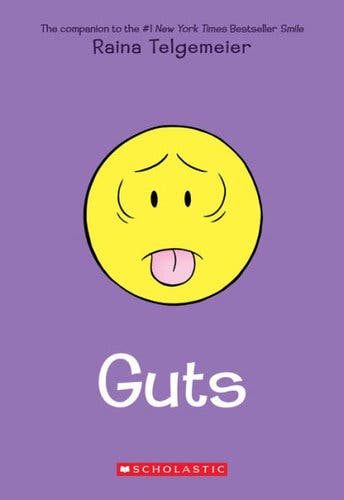What drove me to share Telgemeier’s latest book, GUTS (Scholastic, 224 pp., $24.99; ages 8 and up), with my therapist was not her rendering of the social ecology of fourth grade — though her skill at that puts her in the rarefied company of writers like Judy Blume and Beverly Cleary — but rather the accuracy and vividness with which she conveys the phenomenology of anxiety. No other book I have read on the subject — and to say I have read a lot of them is an understatement — has captured with such brilliant economy and psychological acuity what a severe phobia or panic attack is like. So spot on is her portrayal that I wondered if Telgemeier had somehow taken up residence in my amygdala.

But Telgemeier is simply drawing on — and drawing — her own experience. “Guts” is a memoir, the third she’s published, after “Smile”and “Sister.” (She’s also written two works of original graphic fiction — “Drama” and “Ghosts” — and illustrated several books for the Baby-Sitters Club graphic novel series.) In “Guts,” a series of events propels Raina, already struggling with the sometimes nerve-racking challenges of navigating fourth grade, into a full-blown anxiety disorder, which begins to take over her life.
One reason the shock of recognition was so strong for me is that fourth-grade Raina’s main phobia happens to be the main one I struggled with as a boy (and still struggle with as an adult) — emetophobia, the pathological fear of vomiting. What’s more, the secondary anxieties and associated symptoms — debilitating phobia of germs and fears around food, intense stage fright, the indignities of a nervous, irritable bowel — that beset young Raina are the same ones I endured at that age. (These fears and symptoms commonly cluster together.) Scene after scene rang true to me; the familiarity was almost painful — in places almost a form of exposure therapy. When I was a child (and not only when I was a child), anxiety generally — and the fear of vomiting in particular — felt like a peculiar and embarrassing affliction, and I tried to hide it from my peers, out of shame and fear of stigmatization, going to great lengths to conceal my weekly visits to a psychotherapist. Raina at first endeavors to do the same.
In all three of Telgemeier’s memoirs, Raina contends with the abiding stresses of sibling rivalry and parental discord and mean girls at school. But whereas in those earlier books anxiety is merely a subtheme, an element of Raina’s personality that sometimes figures into the story, in “Guts” it is the force that drives the plot. That Telgemeier is only now, in her third memoir, telling the story of her childhood anxiety straight on could be because it took her a while to gin up the courage to write about this particular set of vulnerabilities. Or it could be because she perceived that we’ve reached a moment when a book like this could be very helpful to her audience.
Children are struggling. Over the last decade, cases of anxiety disorder in young people have increased by 20 percent or more. Rates of suicide and suicidal thinking have risen sharply among young people of all ages — including, horrifyingly, children under 11. Scholars debate why this is happening — plausible culprits include social media, video gaming, helicopter parenting, school shootings and lockdown drills, overweening college pressure, and both the over- and under-prescribing of medication, among other things — but the fact of steadily rising numbers of children with anxiety and depression is hard to dispute.
 EU News Digest Latest News & Updates
EU News Digest Latest News & Updates



